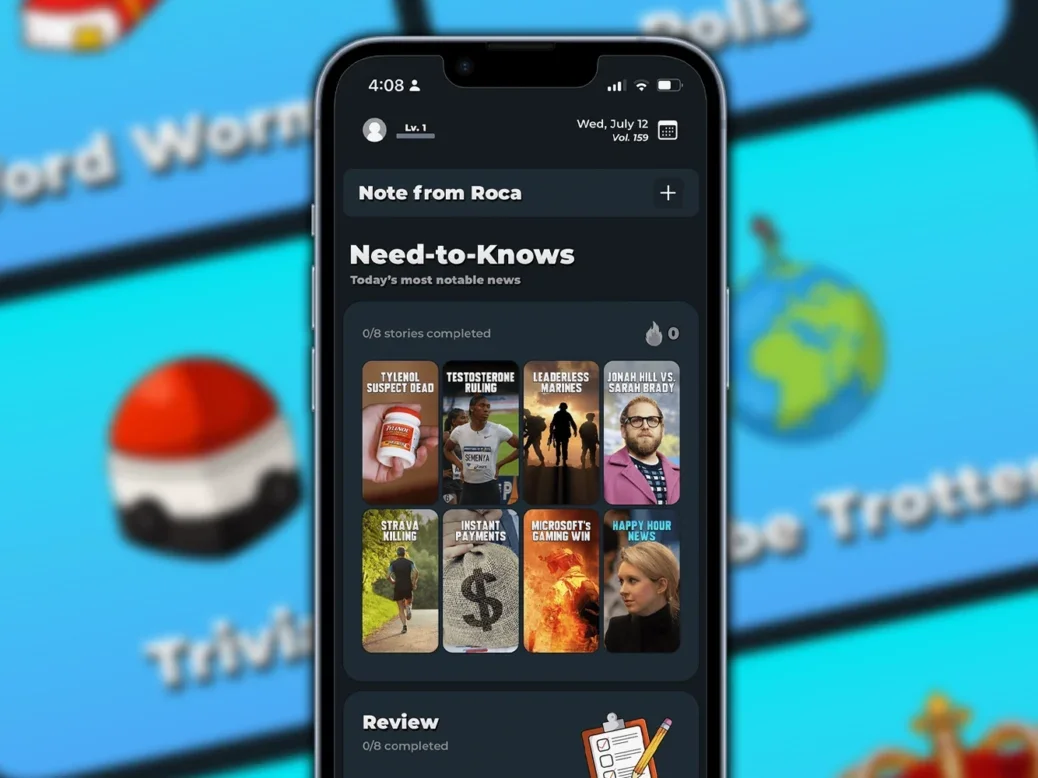
An American news start-up says it is proving Gen Z audiences will pay for news if it’s done the right way.
RocaNews launched in 2020 and now operates via Instagram, a gamified news app, two daily newsletters and Youtube.
It claims to have more than two million regular readers overall and became profitable in October.
It is aiming to reach 18 to 35 year-olds, meaning Gen Z and younger millennials, and about three-quarters of its audience is in the US (followed by the UK, Australia and Canada).
Co-founder Billy Carney told Press Gazette that RocaNews takes a “less is more” approach to the news and tries to “keep it light and just keep it directly to what people need to know” as an antidote to doomscrolling on social media.
Carney did not come from a news background but worked in investment banking for two years after finishing college, admitting he “tried to avoid the news at all costs”.
But in 2020 after the Covid-19 pandemic hit, Carney said it “started to become abundantly clear” to him that there were “two entirely different narratives – it’s like they’re talking about two different pandemics”.
He and two friends, Max Towey who he knew from college and Max Frost who was working with Towey at the American Enterprise Institute, decided to start a news company that “solved this problem”.
Carney said: “Our mission was twofold. The problem was young people weren’t engaging with the news and also just that, as I mentioned with Covid, everything was so kind of inflammatory.
“So on one side, we wanted to re-engage young people with the news by making products that we ourselves would want to consume. And then the other side of it was making something that was non-partisan and just kind of telling people what’s going on without giving 2,000 words of what we think about it.”

Carney admitted that in the first few months of the project “we were throwing shit at the wall and seeing what stuck and nothing stuck”.
They eventually decided to focus on Instagram: “At the time it’s what we used the most so we figured other people are probably doing the same thing.” The page now has 1.6 million followers.
They moved away from the then-ubiquitous style of news publisher posts on Instagram that featured a photo and paragraph in the caption that ended with “link in bio”, urging users to click through to read the rest via the only section of a page that allowed users to share hyperlinks (links can now also be included in time-limited Instagram Stories).
Instead, Carney said, RocaNews posted memes and whole stories on Instagram using different photo slides and “delivered the entirety” of what people needed to know rather than simply using the platform as a “method of pushing people elsewhere”.

Carney said that to reach Gen Z and younger millennials, newsbrands “have to meet them where they are, especially if they weren’t going and seeking out news”.
He cited the Reuters Institute’s Digital News Report in 2020, the year RocaNews launched, that said those aged 18 to 24 “have an even weaker connection with websites and apps [than older generations] and are more than twice as likely to prefer to access news via social media”.
By 2024, 15% of respondents to the latest Digital News Report from 12 key markets said they had used Instagram for news in the past week, up from 2% ten years earlier.

The 2023 report noted that young people are unlikely to change their media habits towards news websites as they get older: “Whether or not legacy media feel they have completed their initial digital transformation from print, or broadcast-focused, to digitally focused brands with a compelling news website and app, they now face a continual transformation of digital as generations come of age who eschew direct discovery for all but the most appealing brands.”
RocaNews does not have a news website (other than a basic one showcasing the brand). Carney said: “Coming from a place with no legacy affiliations, I think, certainly has its benefits and drawbacks. But one of the benefits is that we built our entire business model without any constraints or thoughts of how it should be. And the biggest one of that is not really having a website.”
He said the benefit of delivering news to people who have chosen to follow or subscribe on Instagram or the newsletters is it can “create a bit of a healthier space” at a time of “incendiary headlines” and they did not want to play the game of driving clicks to a website through Facebook links.
RocaNews has two daily newsletters: one is a news round-up with hundreds of thousands of subscribers and the other is a paid offering with a deep dive about one topic.

‘Everybody told us young people would not pay for the news’
The paid newsletter launched in early February and had more than 1,000 people sign up in the first month.
Carney said: “We thought young people would not pay for the news. That’s what everybody told us and we kind of agreed with them, but… one day we’re like ‘alright, let’s just try it.”
He said they were “blown away” by the initial response, adding: “It made us rethink the question of maybe young people will pay for news. It’s just that they don’t have a brand they trust or want to pay for. That makes us kick ourselves for not doing this four years ago. But we’re going from here.”
The other RocaNews product with a paid offering, although it is also available for free, is its app (pictured, top) which launched around 18 months ago.
Carney described the app as a “Duolingo-esque gamified news platform” referring to the language-learning app that allows users to build a streak, earn experience points (XP) and win rewards for reaching certain milestones. Last month Press Gazette launched on another gamified app called Newsreel which is aimed at US college students.
The RocaNews app includes both daily news and deep dives, with users getting XP when they read a story which means they can unlock levels and new features like different avatars.
There are also games like one in which users see a photo of a news story and guess where it is taking place on a map before reading the actual article.
Users on the r/RocaNews subreddit page post to boast about their streaks or complain if the app is down, putting their streak at risk.
Carney said about 35% of users pay to get extra features and content. Overall the app has tens of thousands of users on a monthly basis, he added.
The games aspect of the app has a “learning curve getting people to do it, but once they do it, they do stick around,” Carney said.
He explained that if people use the app a few times in the first week they download it, the retention rate is around 80% a year later.
“So people who start using it, it becomes entrenched and it’s awesome. The challenge is, of course, getting people to that point.”
The other major variable for engagement, he said, is whether people already know RocaNews from its newsletters or Instagram before they download the app. If they find it through the App Store (the app is currently only available on Apple, not Android) the retention rate is lower. Overall the new user retention after one week is about 40%.
Carney claimed theirs is one of the most highly-rated news apps in the App Store: at the time of writing, RocaNews, The Guardian and The Economist all have 4.8 stars out of five.
[Read more: How under-35s’ interest in news has collapsed and what we can do about it]
The RocaNews team is also increasing their video output, primarily on Youtube, producing on-the-ground content rather than daily news.
Part of the reason for the expansion in video is the advertiser outreach on videos is “remarkable compared to what we get everywhere else”,” Carney said. He added that they wanted to increase “the personality or emotional attachment” audiences might feel in response to a story, saying this can be a “deeper, more meaningful” experience than reading an article.
Recent videos have included going “inside America’s most toxic town”, which formerly had the world’s largest open-pit uranium mine, and “inside New Mexico’s poorest region”.
RocaNews ‘absolutely wants to have more paid products’
As of last year, when the three co-founders made the Forbes 30 Under 30 list, RocaNews had received $5.36m in investment.
Revenue in 2023 was about $350,000 and Carney said they crossed $1m in annualised recurring revenue in November 2024. The operation became profitable a month earlier in October.
RocaNews has until recently mostly made revenue from advertising but Carney said they have made a concerted effort to diversify and now it is roughly 45% advertising, 45% subscriptions and 10% video. Events could also come in the future but are further off.
Advertising runs across most RocaNews products, including Instagram, newsletters and host reads on Youtube (as well as the brand receiving ad revenue share from the platform).
Carney said they “absolutely want to have more paid products” but it depends on the growth rate of what they already have.
Asked why RocaNews is working when other newsbrands fail to connect with young audiences, Carney said: “We just built news for the way we’d want to read it.
“Not to say the model is too antiquated to survive, but realistically, college students don’t read news articles online. They just don’t. The way people interact with the internet is so different than it was ten years ago. And I guess we just treat news as a two-way street, and I think that’s gone a long way in terms of building trust with people.”
He added that the team do AMAs (ask me anything) sessions, respond to every email they receive and go out to meet the audience in person. They also pop up to respond to queries or concerns on the r/RocaNews subreddit.
The team is five (about to be six) full-time staff, including the three founders. Including part-timers, that doubles. Carney said they all “do a little bit of everything” but it works out as roughly two writers, one videographer, one on product and one on business.
With this small team, there are three ways they find stories and decide what to include in their select coverage: they cover commodified news like major interest rate cuts and they try to find primary sources and build a story if they see something “going crazy” on social media. But they also have a network called Roca reporters of around 30-40,000 people who get in touch with stories and issues that might be of interest.
For example co-founder Max Frost has just gone to Pakistan to film for Youtube and had weeks’ worth of content planned before even going due to tips from this network, Carney said.
The major goal of the RocaNews co-founders is to “become the premier outlet for Gen Z in the US”. The brand’s name comes from Pororoca, an enormous tidal wave that can be surfed twice a year: “It’s a wave that brings people together. That’s Roca’s mission with the news.”
Carney noted that major news companies like The New York Times will have more young audiences overall due to the numbers they reach.
But he said: “We want to just become the biggest in absolute terms for people under 40 in the US.”
Email pged@pressgazette.co.uk to point out mistakes, provide story tips or send in a letter for publication on our "Letters Page" blog

